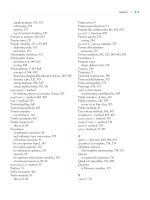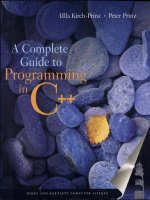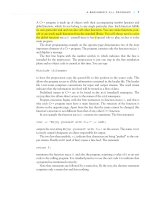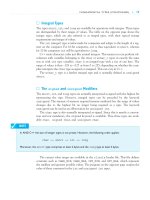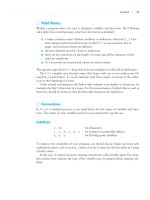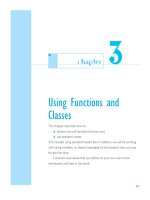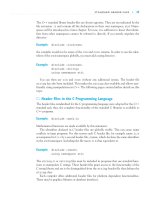A Complete Guide to Programming in C++ part 3 pptx
Bạn đang xem bản rút gọn của tài liệu. Xem và tải ngay bản đầy đủ của tài liệu tại đây (242.74 KB, 10 trang )
Template Instantiation 726
Template Parameters 728
Template Arguments 730
Specialization 732
Default Arguments of Templates 734
Explicit Instantiation 736
Exercises 738
Solutions 742
Chapter 33 Containers 749
Container Types 750
Sequences 752
Iterators 754
Declaring Sequences 756
Inserting in Sequences 758
Accessing Objects 760
Length and Capacity 762
Deleting in Sequences 764
List Operations 766
Associative Containers 768
Sets and Multisets 770
Maps and Multimaps 772
Bitsets 774
Exercise 778
Solution 780
Appendix 783
Binary Numbers 784
Preprocessor Directives 787
Pre-Defined Standard Macros 792
Binding C Functions 793
Operators Overview 795
Operator Precedence Table 797
ASCII Code Table 798
Screen Control Sequences 800
Literature 801
Index 803
CONTENTS
■
xix
This page intentionally left blank
1
Fundamentals
This chapter describes the fundamental characteristics of the object-
oriented C++ programming language. In addition, you will be introduced
to the steps necessary for creating a fully functional C++ program.The
examples provided will help you retrace these steps and also
demonstrate the basic structure of a C++ program.
chapter
1
2
■
CHAPTER 1 FUNDAMENTALS
■
DEVELOPMENT AND PROPERTIES OF C++
Characteristics
C++
C
-universal
-efficient
-close to the machine
-portable
OOP
-data abstraction
-data hiding
-inheritance
-polymorphism
Extensions
-exception handling
-templates
DEVELOPMENT AND PROPERTIES OF C++
■
3
ᮀ Historical Perspective
The C++ programming language was created by Bjarne Stroustrup and his team at Bell
Laboratories (AT&T, USA) to help implement simulation projects in an object-ori-
ented and efficient way. The earliest versions, which were originally referred to as “C
with classes,” date back to 1980. As the name C++ implies, C++ was derived from the C
programming language: ++ is the increment operator in C.
As early as 1989 an ANSI Committee (American National Standards Institute) was
founded to standardize the C++ programming language. The aim was to have as many
compiler vendors and software developers as possible agree on a unified description of
the language in order to avoid the confusion caused by a variety of dialects.
In 1998 the ISO (International Organization for Standardization) approved a stan-
dard for C++ (ISO/IEC 14882).
ᮀ Characteristics of C++
C++ is not a purely object-oriented language but a hybrid that contains the functionality
of the C programming language. This means that you have all the features that are avail-
able in C:
■ universally usable modular programs
■ efficient, close to the machine programming
■ portable programs for various platforms.
The large quantities of existing C source code can also be used in C++ programs.
C++ supports the concepts of object-oriented programming (or OOP for short),
which are:
■ data abstraction, that is, the creation of classes to describe objects
■ data encapsulation for controlled access to object data
■ inheritance by creating derived classes (including multiple derived classes)
■ polymorphism (Greek for multiform), that is, the implementation of instructions
that can have varying effects during program execution.
Various language elements were added to C++, such as references, templates, and excep-
tion handling. Even though these elements of the language are not strictly object-ori-
ented programming features, they are important for efficient program implementation.
4
■
CHAPTER 1 FUNDAMENTALS
function1
data1
data2
function2
function3
object1
Properties
Capacities
object2
Properties
Capacities
■
OBJECT-ORIENTED PROGRAMMING
Traditional concept
Object-oriented concept
OBJECT-ORIENTED PROGRAMMING
■
5
ᮀ Traditional Procedural Programming
In traditional, procedural programming, data and functions (subroutines, procedures) are
kept separate from the data they process. This has a significant effect on the way a pro-
gram handles data:
■ the programmer must ensure that data are initialized with suitable values before
use and that suitable data are passed to a function when it is called
■ if the data representation is changed, e.g. if a record is extended, the correspon-
ding functions must also be modified.
Both of these points can lead to errors and neither support low program maintenance
requirements.
ᮀ Objects
Object-oriented programming shifts the focus of attention to the objects, that is, to the
aspects on which the problem is centered. A program designed to maintain bank
accounts would work with data such as balances, credit limits, transfers, interest calcula-
tions, and so on. An object representing an account in a program will have properties
and capacities that are important for account management.
OOP objects combine data (properties) and functions (capacities). A class defines a
certain object type by defining both the properties and the capacities of the objects of
that type. Objects communicate by sending each other “messages,” which in turn acti-
vate another object’s capacities.
ᮀ Advantages of OOP
Object-oriented programming offers several major advantages to software development:
■ reduced susceptibility to errors: an object controls access to its own data. More
specifically, an object can reject erroneous access attempts
■ easy re-use: objects maintain themselves and can therefore be used as building
blocks for other programs
■ low maintenance requirement: an object type can modify its own internal data
representation without requiring changes to the application.
6
■
CHAPTER 1 FUNDAMENTALS
Editor
Compiler
Linker
Executable
file
Source file Header file
Standard
library
Other
libraries,
object files
Object file
■
DEVELOPING A C++ PROGRAM
Translating a C++ program
If the source file contains just one syntax error, the compiler will report an error. Additional error
messages may be shown if the compiler attempts to continue despite having found an error. So when
you are troubleshooting a program, be sure to start with the first error shown.
DEVELOPING A C++ PROGRAM
■
7
✓
NOTE
The following three steps are required to create and translate a C++ program:
1. First, a text editor is used to save the C++ program in a text file. In other words,
the source code is saved to a source file. In larger projects the programmer will nor-
mally use modular programming. This means that the source code will be stored in
several source files that are edited and translated separately.
2. The source file is put through a compiler for translation. If everything works as
planned, an object file made up of machine code is created. The object file is also
referred to as a module.
3. Finally, the linker combines the object file with other modules to form an exe-
cutable file. These further modules contain functions from standard libraries or
parts of the program that have been compiled previously.
It is important to use the correct file extension for the source file’s name. Although
the file extension depends on the compiler you use, the most commonly found file exten-
sions are .cpp and .cc.
Prior to compilation, header files, which are also referred to as include files, can be
copied to the source file. Header files are text files containing information needed by var-
ious source files, for example, type definitions or declarations of variables and functions.
Header files can have the file extension .h, but they may not have any file extension.
The C++ standard library contains predefined and standardized functions that are
available for any compiler.
Modern compilers normally offer an integrated software development environment, which
combines the steps mentioned previously into a single task. A graphical user interface is
available for editing, compiling, linking, and running the application. Moreover, addi-
tional tools, such as a debugger, can be launched.
In addition to error messages, the compiler will also issue warnings. A warning does
not indicate a syntax error but merely draws your attention to a possible error in the pro-
gram’s logic, such as the use of a non-initialized variable.
8
■
CHAPTER 1 FUNDAMENTALS
#include <iostream>
using namespace std;
int main()
{
cout << "Enjoy yourself with C++!" << endl;
return 0;
}
■
A BEGINNER’S C++ PROGRAM
Sample program
Screen output
Enjoy yourself with C++!
Structure of function main()
Function name
What the program does
(satements)
Type of function
End of function
Beginning of
function
Function block
int main()
{
}
.
.
.
.
What the program does
(statements)
